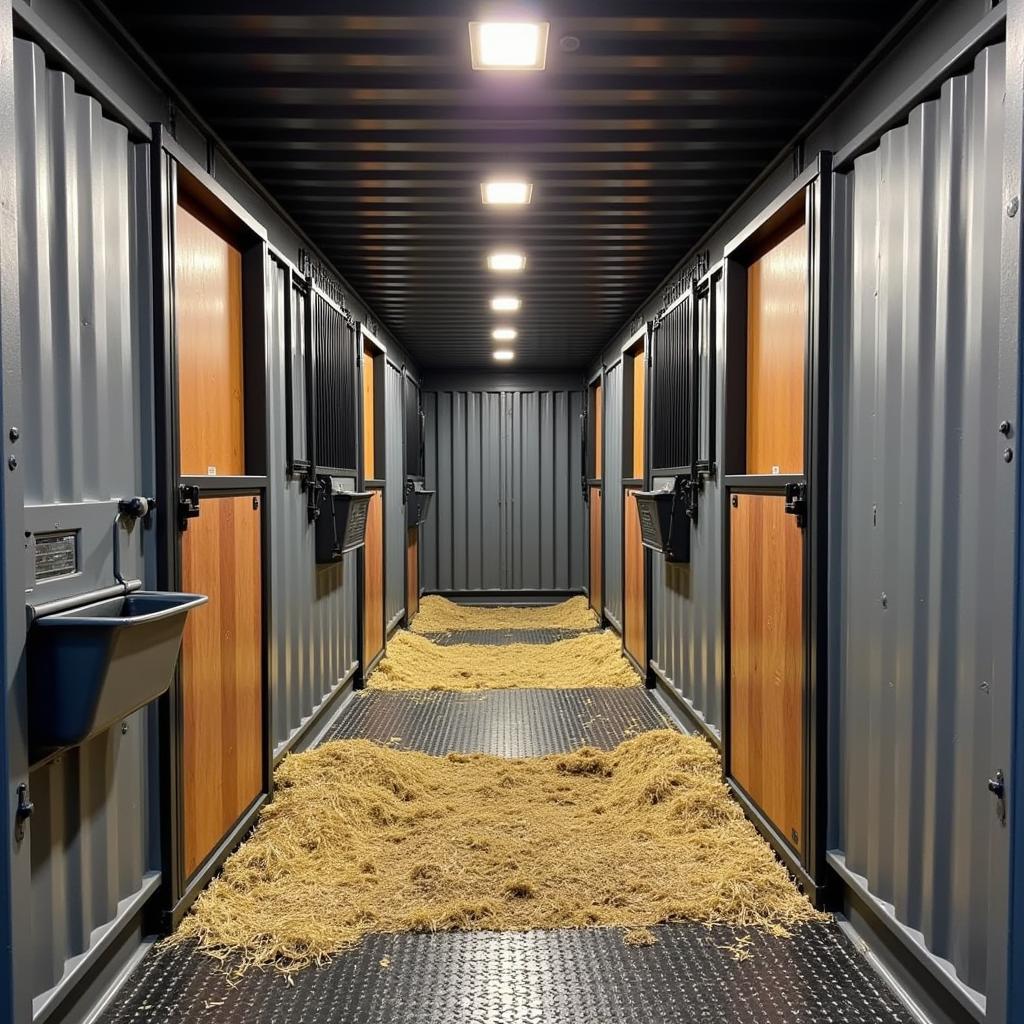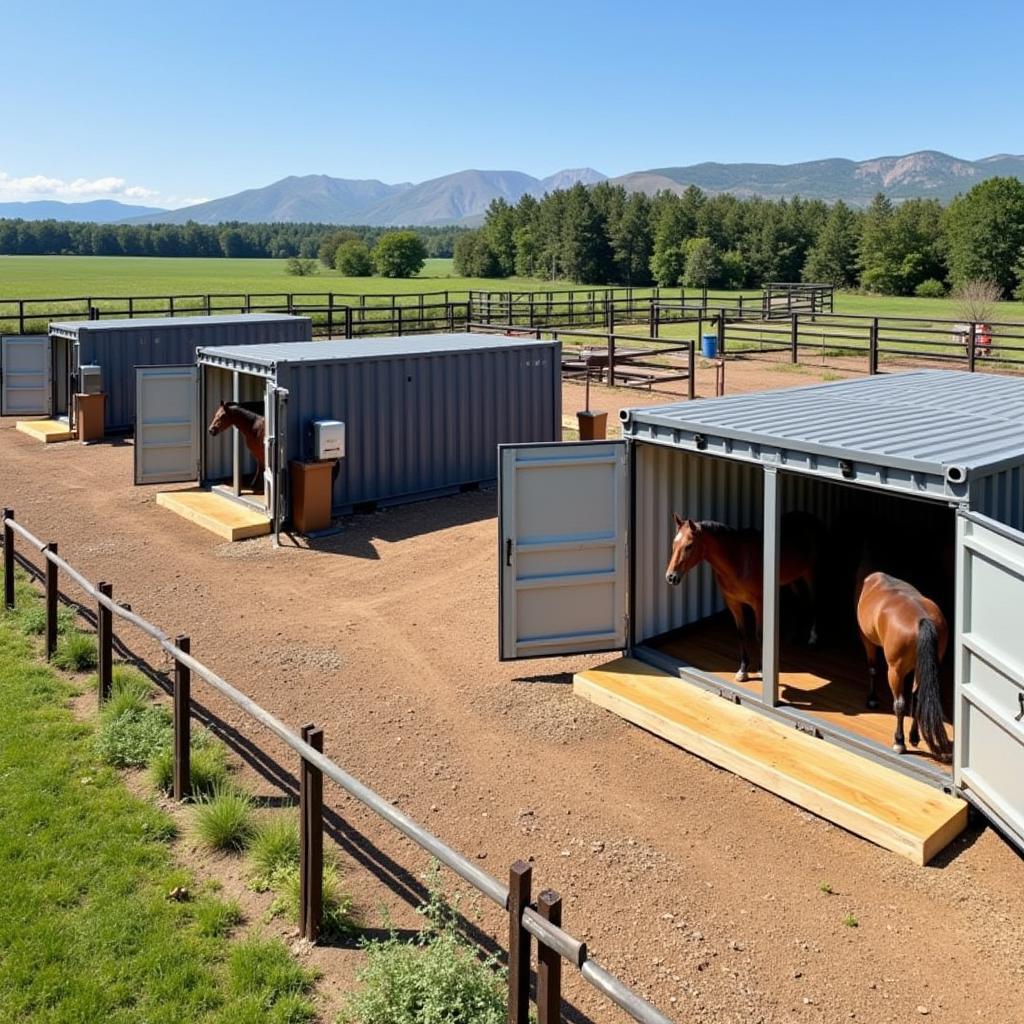Shipping Container Horse Stalls have been gaining popularity among horse owners in recent years as a cost-effective and practical solution for equine housing. Durable, versatile, and surprisingly adaptable, these modified steel containers can provide a comfortable and secure environment for your horses. This comprehensive guide will delve into everything you need to know about shipping container horse stalls, from their benefits and drawbacks to design considerations and cost breakdowns.
 Modern shipping container horse stalls with exterior access doors
Modern shipping container horse stalls with exterior access doors
Why Choose Shipping Container Horse Stalls?
There are many reasons why horse owners are increasingly opting for shipping container stalls over traditional barn setups. Let’s explore the key advantages:
- Durability & Longevity: Built to withstand harsh seafaring conditions, shipping containers are inherently robust. Constructed from heavy-gauge steel, they resist rot, pests, and fire, ensuring a long lifespan with minimal maintenance.
- Affordability: Compared to traditional construction, shipping container stalls can be significantly more budget-friendly. Their readily available structure reduces labor and material costs, making them a financially attractive option.
- Versatility & Customization: Shipping containers offer remarkable design flexibility. They can be easily modified to accommodate various stall sizes, layouts, and features, allowing you to create a customized space tailored to your horses’ needs.
- Portability & Relocation: One of the most significant advantages of shipping container stalls is their portability. If you need to relocate, your stalls can be easily transported to your new location, saving you the cost and hassle of building new structures.
- Security: The sturdy steel construction of shipping containers provides an inherently secure environment for your horses, offering peace of mind against theft or intrusion.
Considerations Before Investing in Shipping Container Horse Stalls
While shipping container stalls offer numerous benefits, it’s essential to consider potential drawbacks:
- Rust Prevention: Although shipping containers are treated to resist rust, ongoing maintenance is crucial, especially in humid climates. Regular inspections and protective coatings are essential to prevent corrosion.
- Insulation & Ventilation: Steel conducts heat and cold, making insulation vital for regulating temperature inside the stalls. Proper ventilation is equally crucial to ensure fresh airflow and prevent condensation buildup.
- Planning Permission: Before embarking on your shipping container stall project, check local building codes and obtain any necessary permits to ensure compliance with regulations.
Designing Your Ideal Shipping Container Horse Stalls
 Spacious and well-lit interior of a shipping container horse stall
Spacious and well-lit interior of a shipping container horse stall
Creating functional and comfortable horse stalls requires careful planning and consideration of your horses’ needs. Here’s a step-by-step guide to help you design your ideal setup:
- Determine Your Space Requirements: Assess the number of horses you need to accommodate and determine the appropriate stall dimensions. Standard stall sizes range from 10ft x 10ft to 12ft x 12ft, but you can customize based on breed and size considerations.
- Choose Your Layout: Decide on the stall configuration that best suits your needs. Popular options include individual stalls, side-by-side stalls, or a combination of both.
- Prioritize Ventilation & Insulation: Adequate ventilation is crucial for air quality and temperature control. Incorporate windows, roof vents, and potentially fans to promote airflow. Consider insulating the walls and ceiling to regulate temperature fluctuations.
- Flooring Options: Choose durable, non-slip flooring that provides adequate cushioning for your horses. Popular options include rubber mats, poured concrete, or interlocking stall mats.
- Access & Safety: Design safe and accessible entrances for your horses. Sliding doors or Dutch doors are popular choices for shipping container stalls, providing convenient access and secure containment.
- Lighting & Electrical: Adequate lighting is essential for visibility and safety. Install interior and exterior lighting, and consider adding electrical outlets for convenience.
Cost of Shipping Container Horse Stalls
The cost of shipping container horse stalls can vary significantly depending on factors such as:
- Size & Number of Stalls: Larger stalls and multiple-stall setups will naturally increase the overall cost.
- New or Used Containers: Purchasing new shipping containers will be more expensive than sourcing used containers. However, used containers may require additional refurbishment.
- Customization & Features: The level of customization, including insulation, ventilation, flooring, and finishes, will impact the final cost.
- Labor Costs: If you’re not undertaking the modifications yourself, factor in labor costs for a contractor.
As a general estimate, basic shipping container horse stalls can start from around $3,000 per stall, while more elaborate setups with custom features can range upwards of $10,000 per stall.
Expert Insight
[Quote by a fictional expert]: “When designing your shipping container stalls, always prioritize your horses’ well-being. Ensure adequate space, ventilation, and natural light to create a comfortable and healthy living environment.” – Dr. Emily Carter, Equine Veterinarian
Frequently Asked Questions
1. Are shipping container horse stalls safe for horses?
Absolutely. When properly designed and outfitted with appropriate features, shipping container stalls can be just as safe as traditional barns, offering protection from the elements and potential hazards.
2. How long do shipping container horse stalls last?
With proper maintenance, including rust prevention and regular inspections, shipping container stalls can last for decades, providing a durable and long-lasting housing solution.
3. Do I need planning permission to build shipping container horse stalls?
Building regulations vary depending on your location. It’s best to consult with your local planning authority to determine if any permits are required for your project.
4. Can I add water and electricity to my shipping container stalls?
Yes, you can hire qualified professionals to connect your stalls to water and electricity sources, making it convenient to provide fresh water and lighting.
5. What type of flooring is best for shipping container horse stalls?
Rubber mats are a popular choice for their durability, cushioning, and ease of cleaning. Other suitable options include poured concrete or interlocking stall mats.
 Shipping container horse stalls with attached individual paddocks
Shipping container horse stalls with attached individual paddocks
Conclusion
Shipping container horse stalls offer a practical, affordable, and customizable solution for housing your equine companions. By carefully considering your horses’ needs and prioritizing design elements like ventilation, insulation, and safety features, you can create a comfortable and secure environment that caters to their well-being.
Do you have questions about shipping container horse stalls or need assistance in planning your equine housing project? Contact Justus Horses USA today at 0772127271 or email [email protected]. Our expert team is available 24/7 to provide personalized guidance and support every step of the way. Visit us at our facility located at QGM2+WX2, Vị Trung, Vị Thuỷ, Hậu Giang, Việt Nam, to see examples of our work and discuss your specific requirements.